Best Dunlop Safety Boots (Reviewed) – Keep Feet Safe and Dry
Dunlop’s brand is virtually synonymous with protective rubber boots. And, their line-up of high-quality waterproof Wellingtons proves that reputation is well-earned.
With over 120 years’ experience crafting protective footwear, Dunlop has become a trusted household name in the UK.
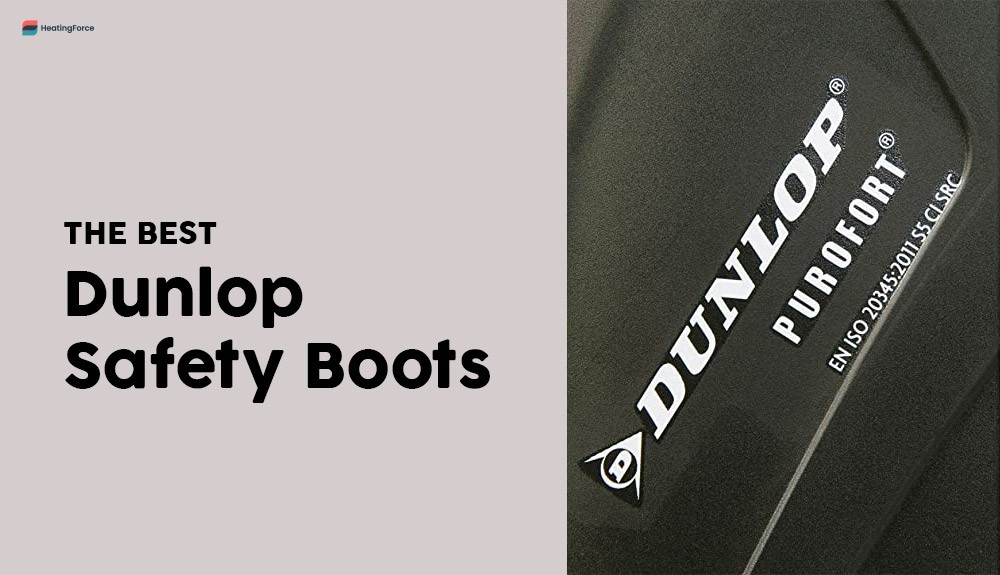
Today, we review the best Dunlop safety boots for any budget or application, from walking the dog to festival-going to farming.
Best Dunlop Safety Boots
Below, we recommend seven Dunlop Wellies that excel within their intended use cases, yet are affordable enough for anyone to purchase.
1. Dunlop Half Wellies
If you’re in search of a waterproof safety boot you can throw on and kick off with ease, you’re probably looking for Dunlop’s Half Wellies. Their wide calves offer generous room for tucking in trousers, though the fit is anything but sloppy.
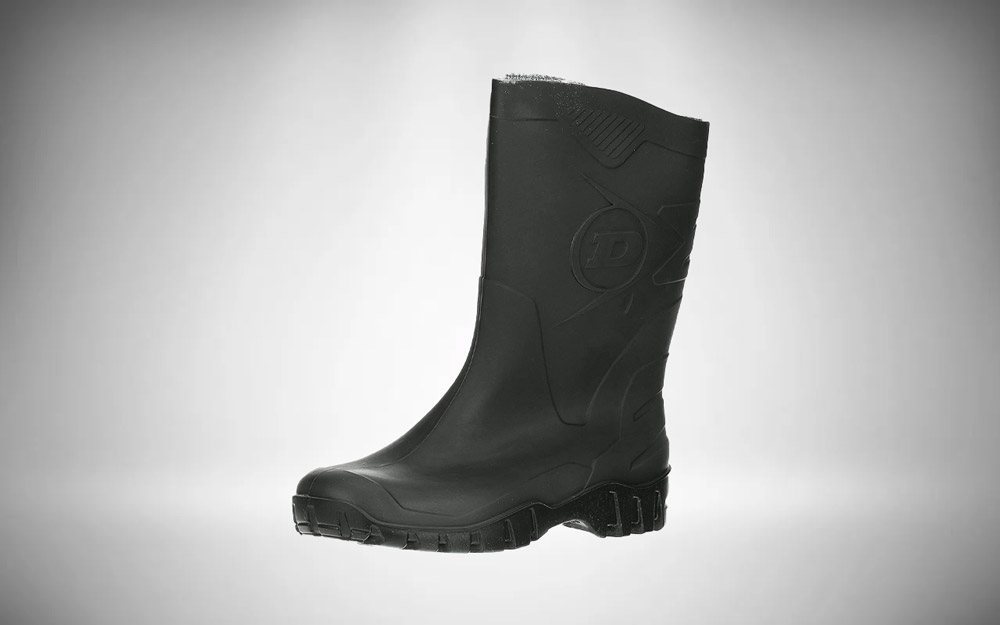
Made of PVC from the ground up, the Dunlop Half Welly is 100% watertight. While there’s no lining inside to specifically combat the cold, they easily accommodate extra-thick socks for greater comfort and thermal insulation. In fact, you’ll probably want to size down at least once, even if you do intend to use double socks.
Dunlop’s soles are as a rule of thumb quite good on slick surfaces, and the Half Welly’s sole is no exception. They’ve got ample tread for going off pavement, and are stable enough to allow for sure footing no matter where you go.
Keep in mind, however, that the Dunlop Half Wellies do NOT have steel toe caps. They’re best suited to dog walking, but can find adequate usage in light agriculture, hunting, or even as leisure wear. They’re especially helpful when you expect to face down mud, minerals, oils, or general filth, as they keep these elements out whilst being easy to clean off.
Pros:
- Low price for a great boot
- Surprisingly durable
- Wide fitting calves for anyone
- Completely waterproof
Cons:
- No protective toecap
- No insole included (though you can easily use your own gel inserts)
2. Dunlop Pricemastor Wellington Boots
Perhaps a half-height boot isn’t for you; then try Dunlop’s knee-high Pricemastor Wellingtons. It bears many of the same virtues as its diminutive counterpart, while offering extended shafts for greater protection against more intense outdoor elements.

Indeed, these are some of the best-selling festival boots, as they’re an inexpensive way to tromp through the mud. Just shy of 45cm tall, you can wade through quite a bit of muck without letting any of it inside. While the boots offer a generous fit and plenty of room to tuck in trousers, they’re not so loose that they’ll get bogged down and slip off your feet.
PVC constitutes the uppers and soles, backed by a synthetic liner fused on to create a 100% waterproof barrier. They’re also highly resilient vs. fertilisers, disinfectants, and other chemicals as well, making them a great choice for landscaping and farming activities that don’t involve heavy machinery.
That last point is especially important, as there’s no steel about the toe or midsole to protect you from kinetic damage. And, while the Pricemastor Wellingtons don’t bear specific marks for slip resistance, most people find the traction adequate for most light-duty tasks.
As far as safety boots go, these are really best suited to fluid protection and not much else. However, if that’s all you need, you’re much better off buying Dunlop than spending two or three times as much on other boots which do the same job.
Pros:
- Superior protection against water, fats, chemicals, and other fluids
- Affordable knee-height Wellingtons
- Neutral styling fits most outfits
- A great festival boot
Cons:
- Average lifespan limited to about a year
- Uppers don’t keep their shape as well as other models
3. Dunlop Blizzard Protective Footwear
While you can wear simple waterproof Wellingtons during the winter, you’re likely to find your feet still get quite cold. Dunlop has improved upon their base design with the Blizzard, which features their special Purofort rubber compound.
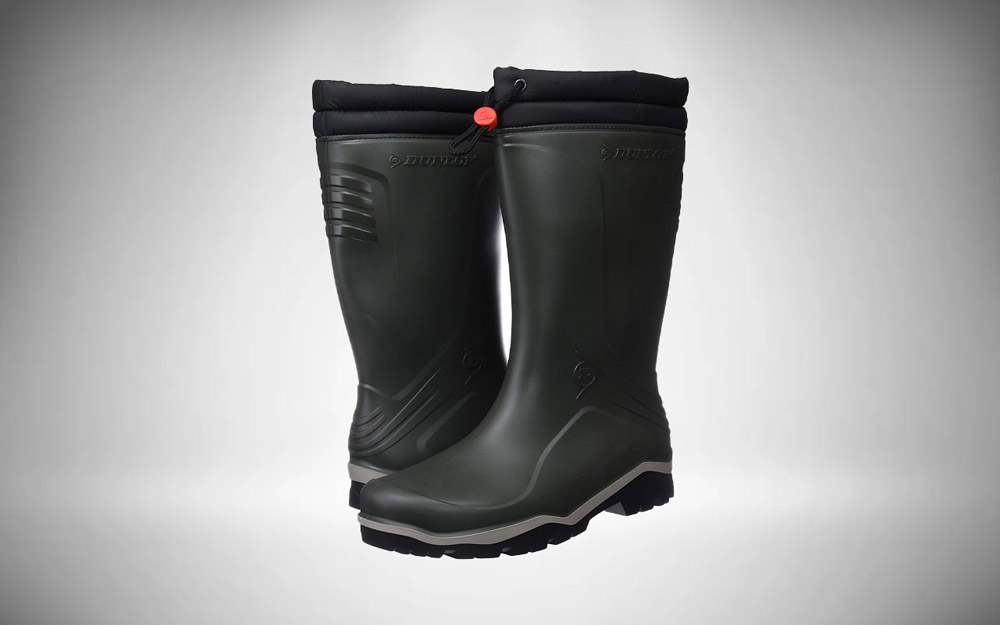
In combination with fur lining, Purofort boots offer meaningful insulation against temperatures as low as -20°C. Thus, you really could wear these safety boots out in a blizzard, and your feet would be no worse for it! They’re effective at keeping out water (frozen or otherwise), as well as acidic and base chemicals, and thus great for all-weather agriculture, animal management, and other similar tasks.
Further improving the thermal protection, Dunlop’s Blizzard has ample padding around the collar, with a drawstring to pull them close against your leg. This effectively forms a seal that traps hot air against your skin while keeping the frost out. One slight annoyance is that you can’t tuck the drawstrings into the collar very easily, and they may flop and catch a bit. But, that’s a small price to pay for protection against sub-zero temperatures.
Durability is another virtue of Purofort, and it’s not unusual to see Dunlop’s Blizzard Wellingtons last for three or more years. The Blizzards have a thicker heel and sole than average, and will not split in the cold. Their treads offer good grip in mud or even icy slush, though you should still exercise caution when walking on ice.
Dunlop’s Blizzard safety boots are a hair over 33cm tall, and are true to size. Just be aware there are no half sizes, so make sure you get a boot you can compensate for with thick socks.
Pros:
- Keeps you warm in -20°C temperatures
- Collar drawstring for a snug fit
- Extremely durable and resistant to splitting
- Better than many wellies twice the price
- Plenty of room to add gel inserts or wear thick winter socks
Cons:
- Not much, though a composite toe cap would round out the package perfectly
4. Dunlop Protomaster FS160/142PP
Finally, we arrive at a pair of Wellingtons that do indeed have a steel toe! Of course, the Protomaster FS160/142PP goes a step further, with a steel shank in the midsole to offer all-round protection vs. impacts, compression, and piercing.
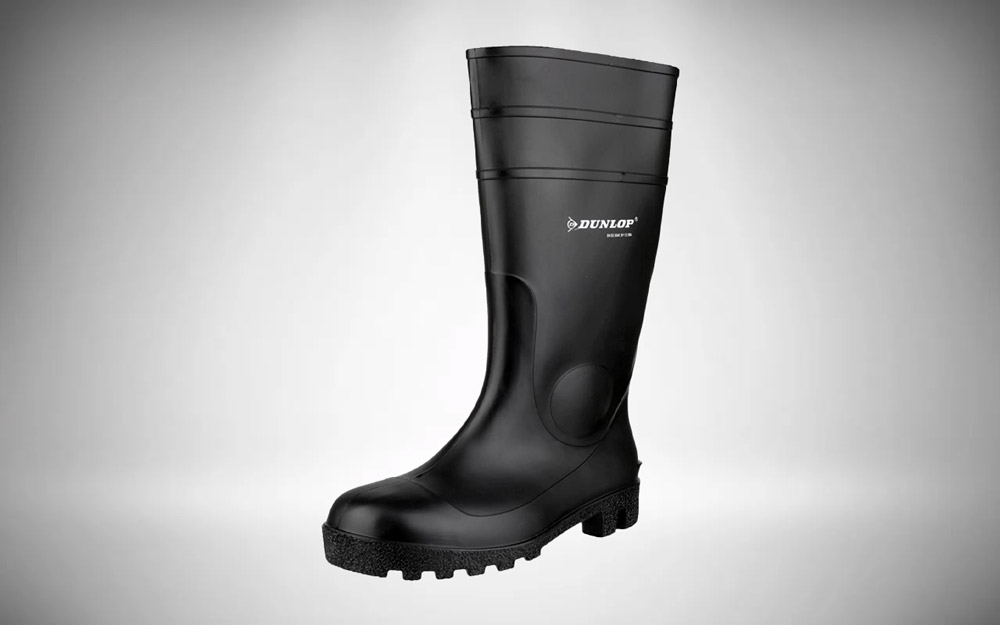
In fact, these Dunlop safety boots actually bear an S5 rating. This means steel armour as mentioned, plus a litany of resistances to oils and fats, chemical disinfectants, acids, and minerals. The Protomaster also offers waterproof abrasion protection, thanks to their tough-as-nails PVC/Nitrile fused uppers.
Dunlop didn’t skimp on the heel, either. Made of a grippy gum rubber, you’ll find your Protomaster safety boots offer exceptional traction on the widest variety of slick surfaces (with an SRC rating to prove it). Moreover, this material bears superior anti-static properties, and is springy enough to absorb the tiresome energy of footfall.
Overall, the FS160/142PP from Dunlop is an immensely practical boot. With humble styling and easy-on wearability, they’ll be the first boots you grab on your way to garden and festival alike. Dunlop offers a wide array of sizes–even children’s sizes–at an affordable price, making foot safety available to anyone.
If there’s one flaw with these, it’s that the first thing to go almost without fail is the rubber over the toe. They’re not the longest-lasting boots, but you won’t feel hard done by considering the cost.
Pros:
- S5 protection for the price of dinner
- Available in all sizes
- Exceptional grip on sole
Cons:
- Heavy
- Rubber splits over the toe
5. Dunlop Explorer C662
Here, we have what is essentially a blending of our previous two boots. The Dunlop Explorer offers full S5 protections, but also features construction of the incredible Purofort material.
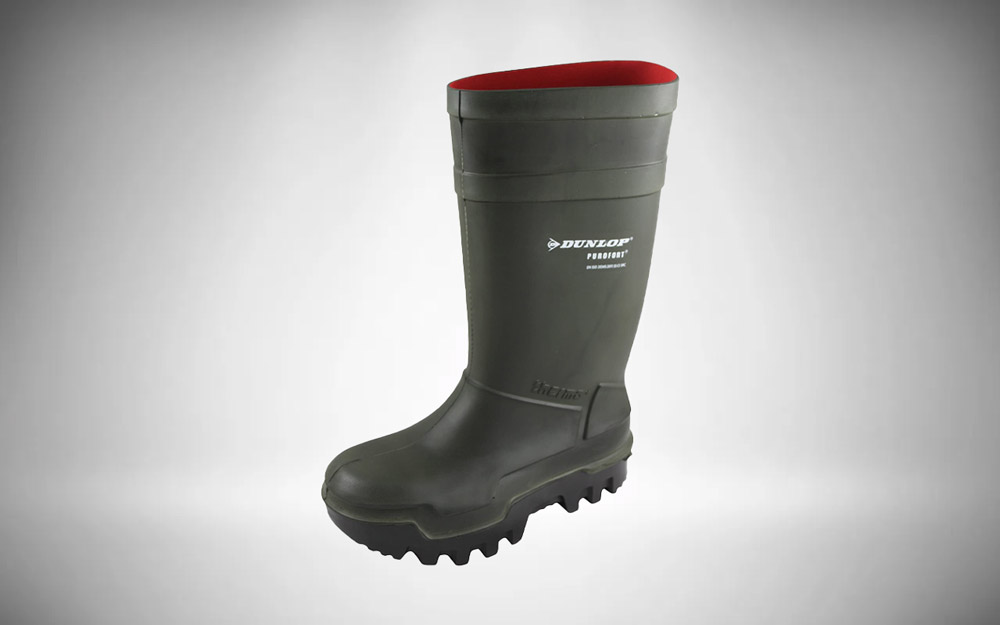
To review, Purofort is a high-durability rubber compound developed by Dunlop to withstand temperatures as low as -20°C. And with synthetic fur lining inside, Explorer safety boots do indeed offer incredible thermal protection, and waterproofing besides.
Purofort also addresses issues with rubber splitting across the steel toe cap. You also don’t have to worry about splitting the oversized sole in cold temperatures or using a spade. Indeed, the explorer is a durable boot that should last you several years’ worth of hard wear.
It does take a little getting used to those massive treads, but you won’t want anything else once you’ve worn them through icy slush or mud. They offer SRC-level slip protection, and are great for absorbing energy through the heel.
While many affordable wellies skip out on including a decent insole, the Explorers contain Dunlop’s Premium PU Insole. This offers great arch support and stability for the surest footing possible.
The C662 Explorer is true to size, though they can run a bit narrow along the foot for some. Nevertheless, this is a reliable model built for agriculture; your Dunlop Explorers will prove worth every penny in whatever you throw at them.
Pros:
- An excellent overall safety boot for any task
- Purofort offers great thermal protection
- Anti-bac lining
- S5 protection
- Lasts years
Cons:
- Narrow last and lack of half sizes can make this a difficult fit for some
6. Dunlop Actifort
Dunlop does heavy duty with their Actifort safety boots–and you don’t even have to pay an arm and a leg to buy them. For the price of lunch for two, you get S5 protections, a generous fit, and rugged good looks.
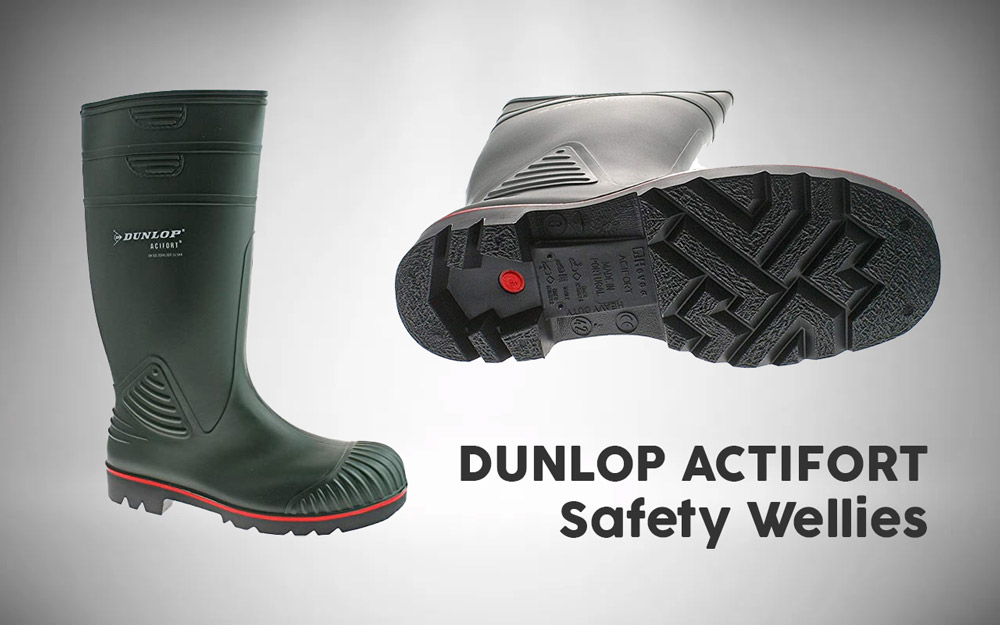
Actifort is another boot material purpose-built by Dunlop. Similar to PVC/Nitrile fusions, Actifort offers water resistance, as well as superior chemical resilience. If you’re going to be working with fertilisers, insecticides, herbicides, disinfectants, or any other harsh compounds, this is the material you want.
To be sure, these boots are well-suited to farm work, animal husbandry, or landscaping. The Actifort uppers do work well to ward off tearing from thorns and thick brush, while the steel toe and midsole guard against all sorts of physical hazards which threaten your fragile foot bones. What’s more, Actifort is more durable than regular rubber, and you’ll have no cracking over the steel toe.
Dunlop’s Actifort boots wear nicely, and are easy to put on with ample room in the calves. And, they’re true to size, and fit well even with regular-sized socks. If you’re a half size, then go up and plan to wear thick socks. They are a bit heavy, but the heel offers anti-fatigue energy absorption, and thus you can wear them for hours without complaint.
Overall, Actifort is a practical investment in the health of your feet, especially if you work with chemicals or in the muck.
Pros:
- Great chemical resistance
- Durable Actifort material wears hard and lasts long
- Roomy in the calves
- Affordable S5 protection
Cons:
- Slip resistance could be better
- Boot probably too heavy for long-distance walks
7. Dunlop Purofort+ Full Safety
If you’re looking for a safety boot that does it all, feast your eyes on the Purofort+ Full Safety from Dunlop. With advanced materials, superior protections, and long-lasting durability, it’s a wonder these don’t cost twice as much as they do.

We’ve already praised Purofort as a wonder material from Dunlop, but their Purofort+ represents a considerable upgrade. Both share the same underlying structure: a patented formula that yields millions of tiny air pockets throughout the cured material. And both offer incredible thermic properties, resistance to cuts, flexibility, and a light weight.
However, Purofort+ takes all of these benefits to the maximum level. These boots offer insulation good for an absurd -50°C, and are yet lighter and stronger than their lesser counterparts. Moreover, Purofort+ provides superior chemical resistances, as well as perfect waterproofing throughout the shaft and sole.
The sole itself offers myriad features as well, including energy absorption in the heel, electrical resistance, and SRC slip resistance. Layered above is Dunlop’s Premium PU insole, which offers arch support and stability. (You can also remove it once it gets worn, or else replace it with your favourite insert.)
Being an S5 boot, the Purofort+ Full Safety of course features high-impact steel about midsole and toe box. Altogether, these are really some of the best safety Wellingtons money can buy, and are well-suited to heavy duty and long hours.
Pros:
- Purofort+ is Dunlop’s most insulating, most durable material
- Great comfort and stability
- Utterly waterproof and resistant to most chemicals and oils
- Cleans off easily
Cons:
- Nothing, though may be more boot than most people need
How to care for your Dunlop Wellies
Owning and wearing rubber boots should, as a rule, be a low-maintenance affair. However, that doesn’t mean your Dunlop wellies won’t benefit from some TLC! Sure, they’ll never last as long as well-conditioned, full-grain leather boots. But with a little care and know-how, you can extend the service life of your rubber work boots significantly–not to mention keep them looking and feeling their best.
Here are a few best practices for maintaining your Dunlop safety boots in top shape:
Air them out between wears
While we rarely give it to them, every shoe on earth appreciates a little time to “rest” after being worn all day. What this means is giving your boot time to reset to its normal shape whilst shedding built-up moisture. In effect, you’re recuperating the flexibility and strength of the material, so it can durably face the challenges of the next day.
However, properly resting your boots involves more than just kicking them off and leaving them for a few hours. If you’ve just come in from the rain, give your Dunlops a quick wipe-down with a dry cloth to remove standing condensation.
Next, take a peek inside the boot: is it exceptionally damp or wet? If so, you can quickly remove interior moisture by lightly packing the shafts with newspaper. An even better option is to use cedar boot trees in place of paper, which not only soaks up humidity but provides structure for the shape of the boot to reform upon.
In either case, you’ll want to store them in a cool, dry area, away from direct sunlight. After all, prolonged exposure to UV light will cause the rubber to become brittle and crack. It is for this reason, too, that we recommend against ever using a radiator or blown-air to speed-dry your boots.
Keep your boots clean
After a particularly dirty job, you might be tempted to give your boots a good wash with soap and water. While the instinct is correct, it’s important to avoid using chemical solvents or disinfectants on your rubber boots. Of course, Dunlop safety boots all have a minimum chemical resistance, and will likely survive such a wash without apparent incident. But repeated exposure will hasten the degradation of your boots, rather than preserving them.
Instead, use cold soap and water with a cloth or soft-bristle brush to manually remove dirt and debris. Don’t forget to remove anything lodged between the treads below, as well–even a tiny pebble can crack a sole if left long enough underfoot. Once you’ve done this, wipe them down with a dry rag and allow to air dry.
Remember, keeping rubber clean is vital to allowing it to rest properly. Built-up dirt will deform the shape of your boot, and may trap in moisture which weakens the rubber’s bonds.
Give them an occasional shine
While many people avoid this step altogether, it’s sometimes nice to smarten up your Dunlop wellies. Just like leather, there exist specially formulated compounds which allow you to shine up your rubber boots. It’s a bit of extra expense, and some time spent buffing them out besides, but it can be worth it for pricier Wellingtons.
Alternatively, you can use toothpaste or a kneaded eraser to spot-treat any stubborn scuff marks.
Finally, you may eventually notice your boots begin to take on a cloudy appearance. This is called blooming, and it is a natural by-product of allowing the rubber to rest. Essentially, impurities work their way to the surface, and collect there in a light film over time.
Leaving the bloom untended will not harm the longevity of your boots, but it will definitely dull-out their appearance. The solution is to simply run a damp cloth to physically remove blooming. Though if you regularly clean your boots, you may never run into this problem.
How to improve the fit of your Dunlop safety boots
Generally speaking, Dunlop designs their boots with ample room to accommodate tucked-in trousers and various leg shapes. That said, the one-size-fits-all approach may lead to boots which don’t quite fit how you’d hoped. Here are a few things to mitigate a poor fit:
- Pay attention to restocking or exchange fees – Many sellers online stand by their customer experience, and will help you exchange an ill-fitting boot free of charge. However, this is not always the case, making it imperative that you check their exchange policy for fees before buying a boot you’ve never worn.
- Install your favourite gel inserts – Many Wellington-style boots feature removable insoles, or else no insoles at all. This allows you to customise the fit with whatever lifts or inserts you prefer. Once again, double check to ensure your boot allows switching insoles before you buy.
- Wear thick socks – Socks help not only to achieve a more snug and cushioned fit, but they can provide crucial insulation that helps you keep warm in wintry slush. Don’t balk at the prospect of doubling up on socks, or even wearing thick bed socks.
- Mind the cold – Some boots are better suited to the cold than others. Boots which only possess waterproofing still leave your foot vulnerable to freezing temperatures–and are more likely to harden and split as well. Well-insulated boots, purpose-built for the cold, will have no such limitations; look for fur lining or Dunlop’s incredible Purofort material if you anticipate wintry weather.
- Don’t attempt to modify your boot – Stretching out the rubber to make a too-small boot bigger is a recipe for disaster. You can easily cause them to deform or split, rendering the waterproofing aspect of your wellies useless. What’s more, most sellers are unwilling to exchange boots which have been modified.
Conclusion
We’ve spent considerable verbiage reviewing many of Dunlop’s best-selling safety boots. At this point, you should have a much clearer idea of which model best suits your needs, as well as the best way to go about making a smart purchase. With a little bit of care, you can get a tonne of value from your relatively inexpensive Dunlop wellies; we’ve also shown you how best to tackle that task, as well.